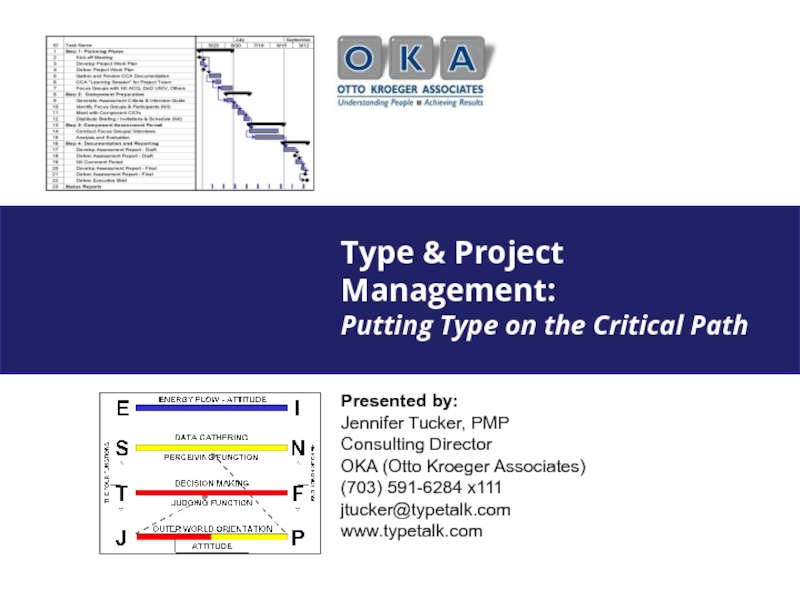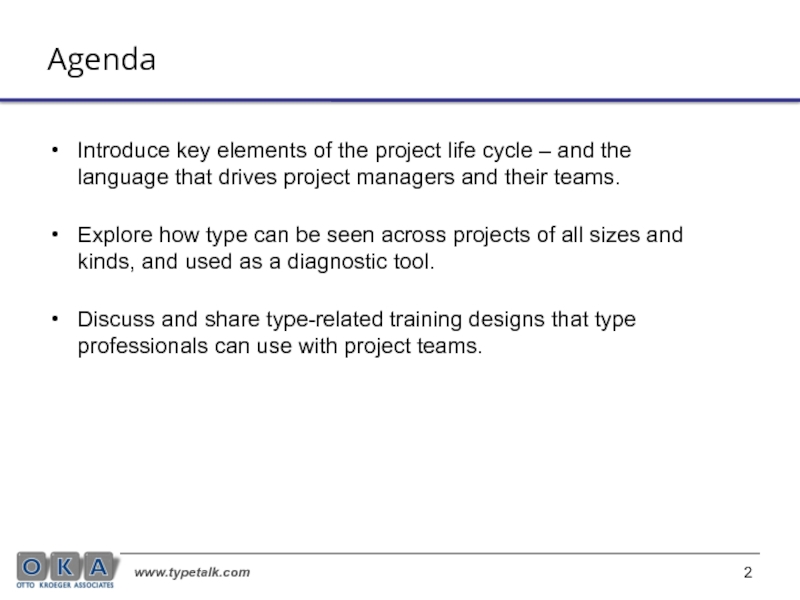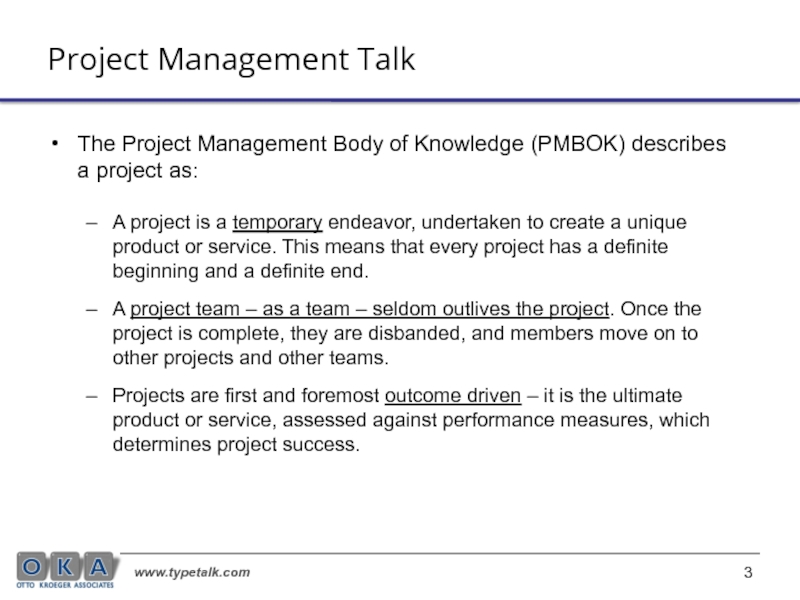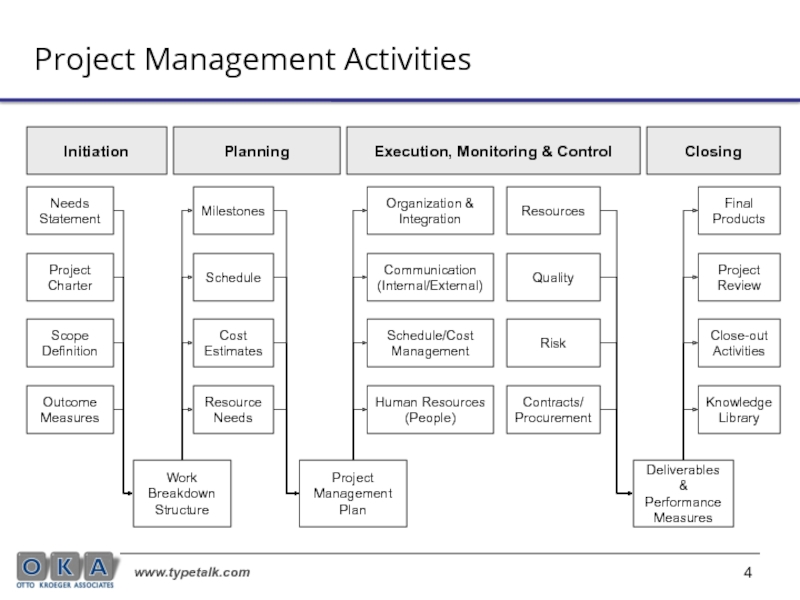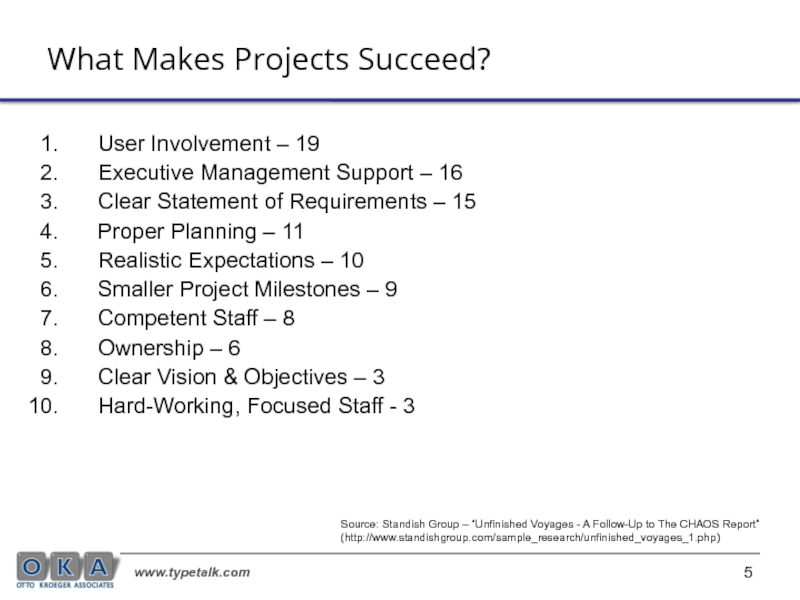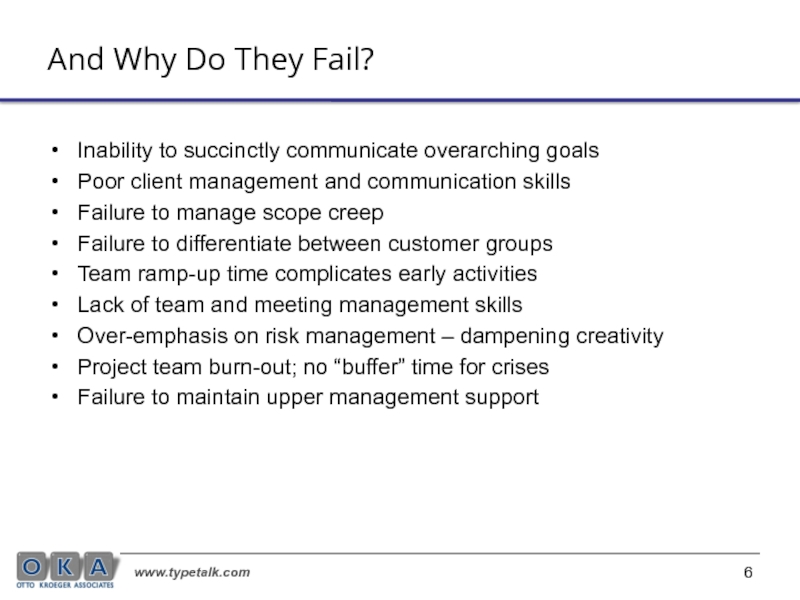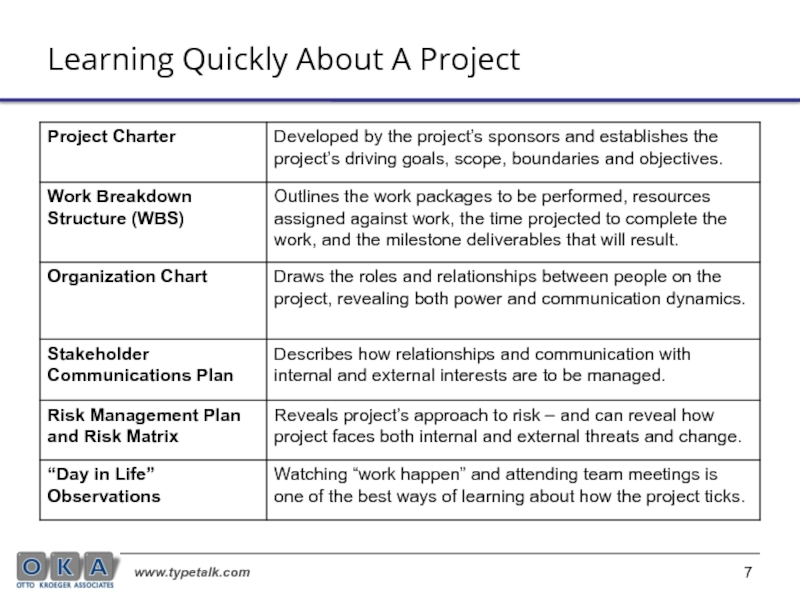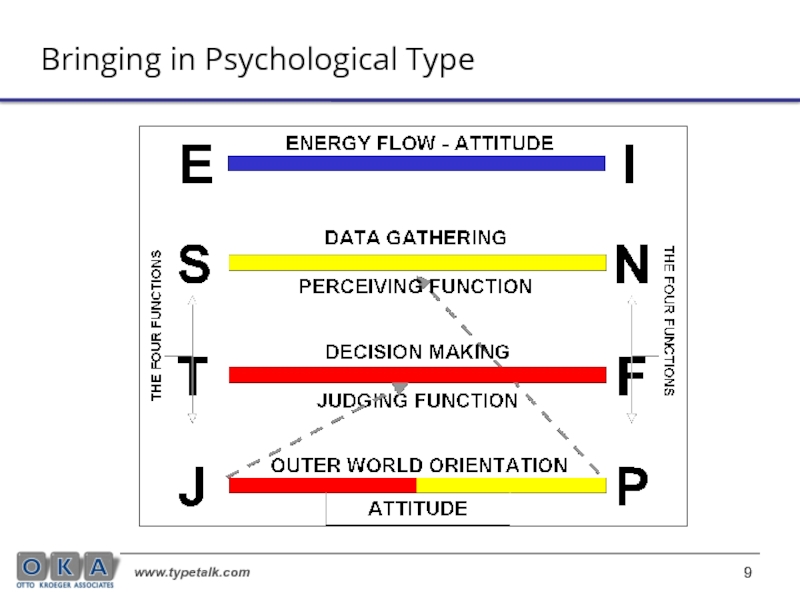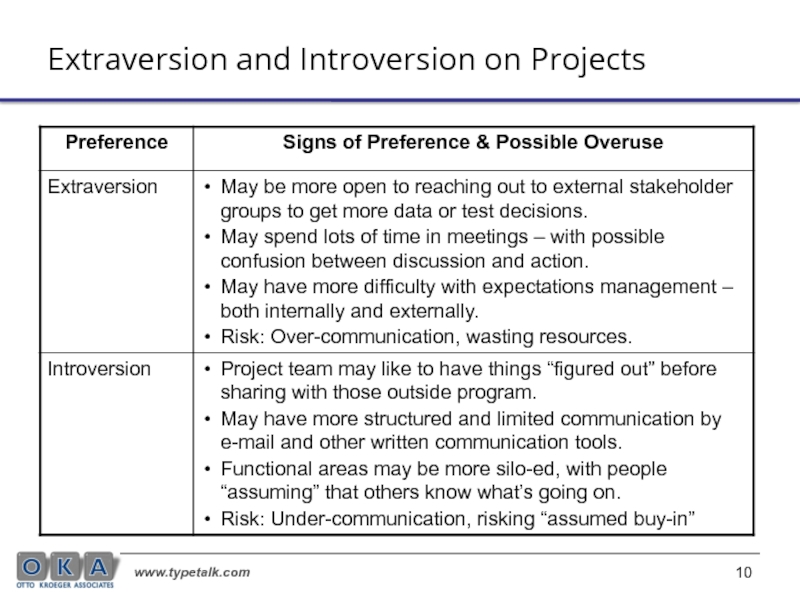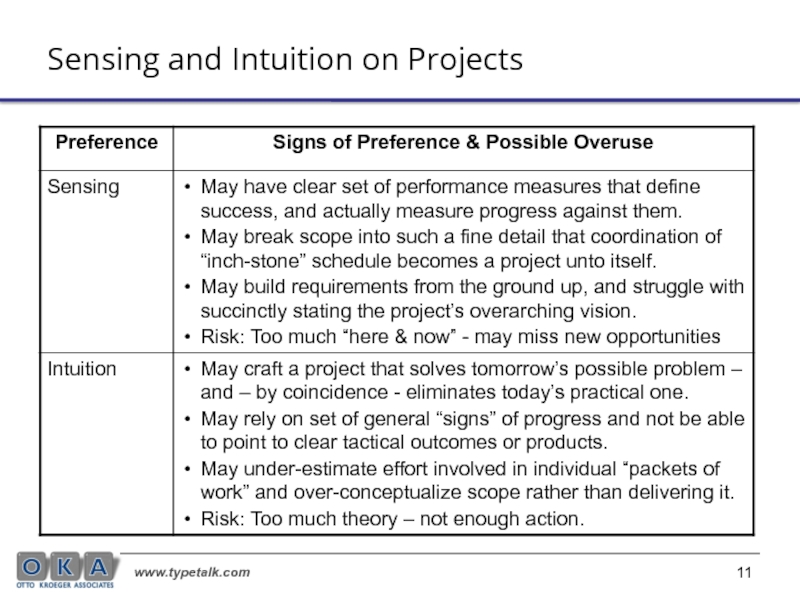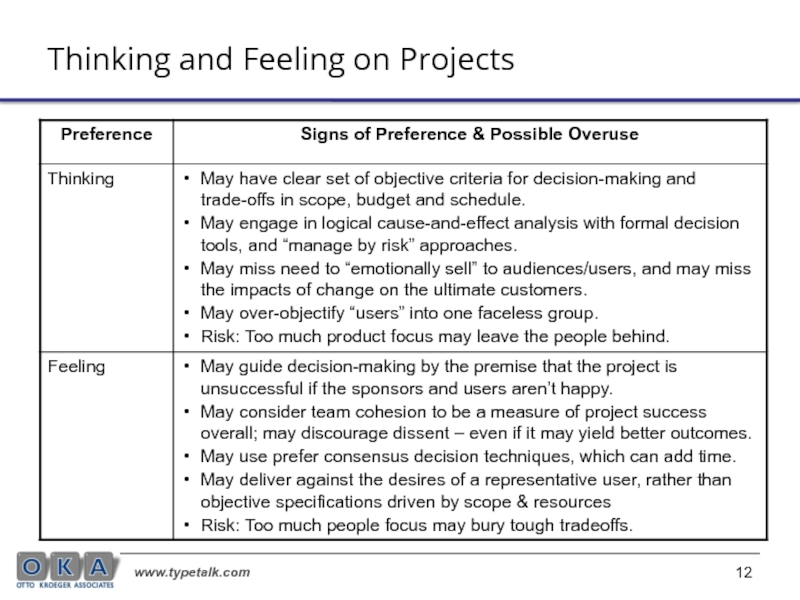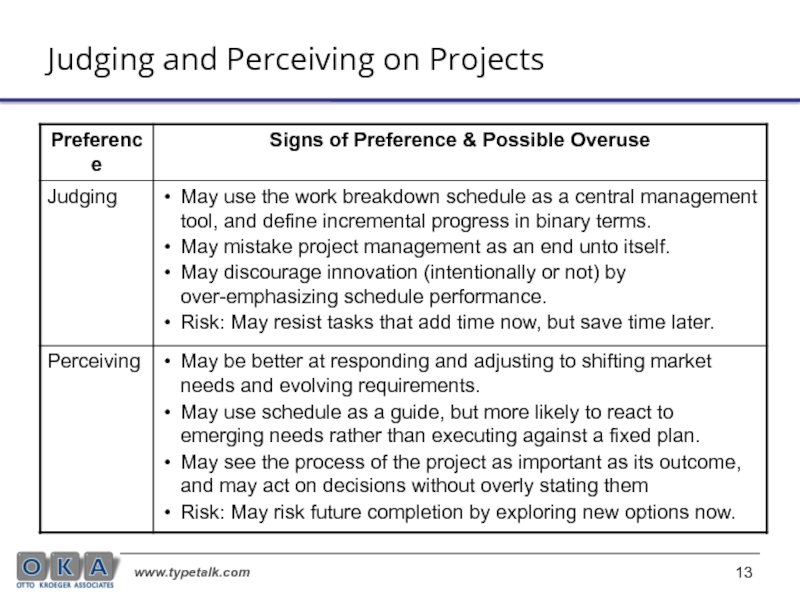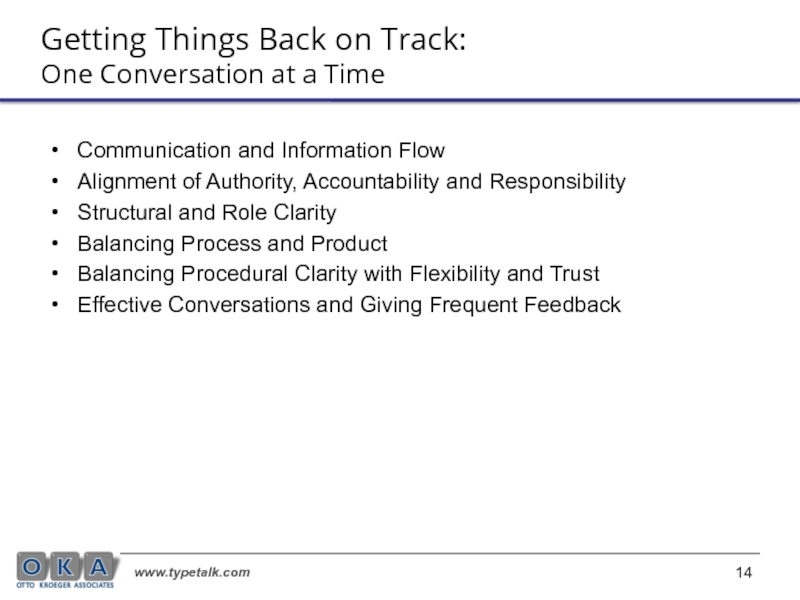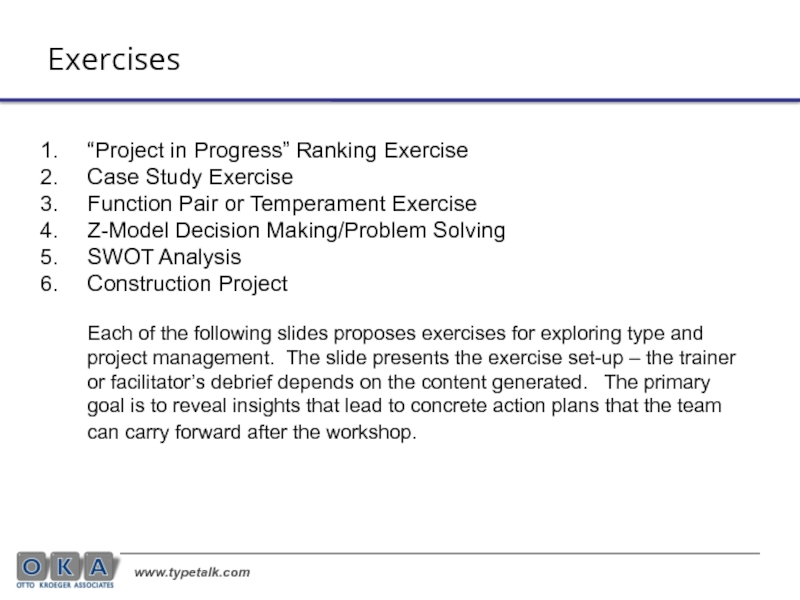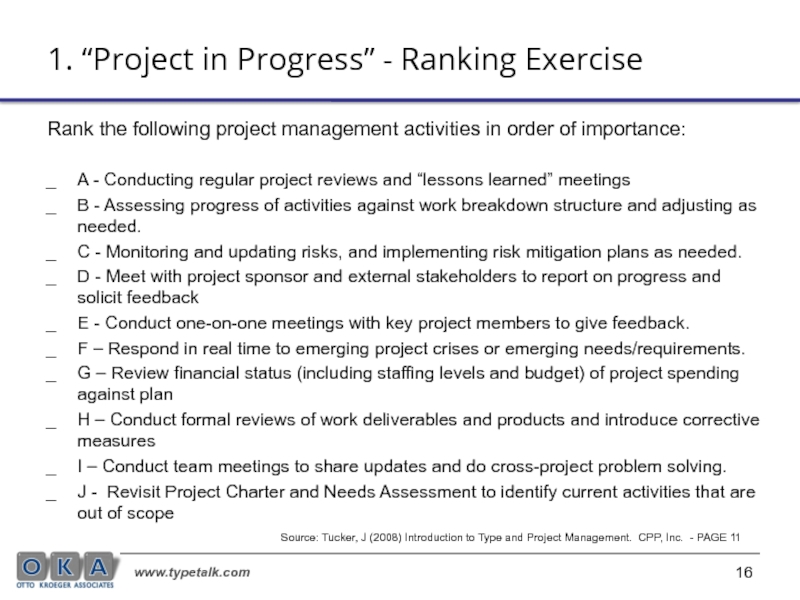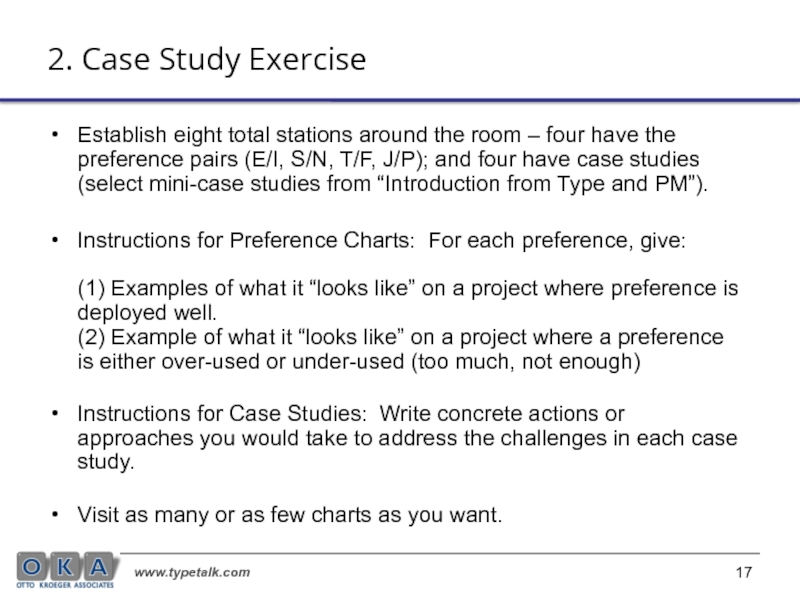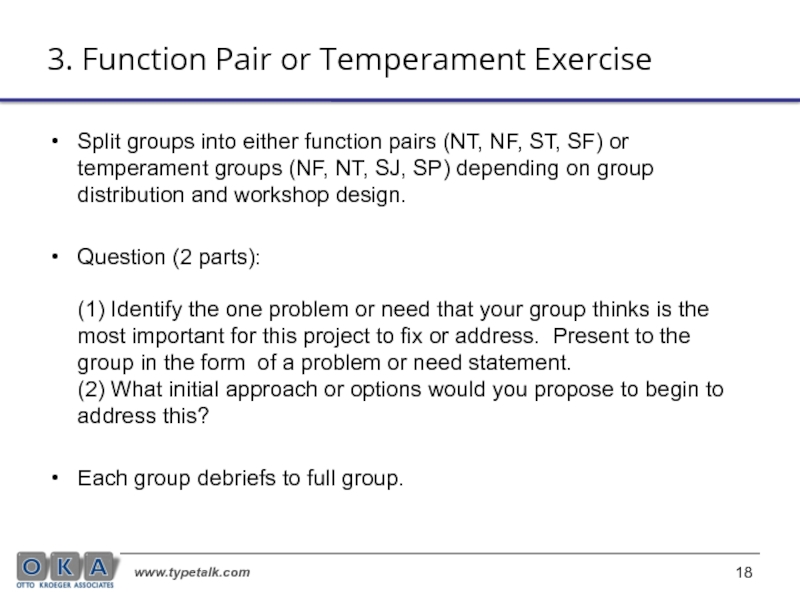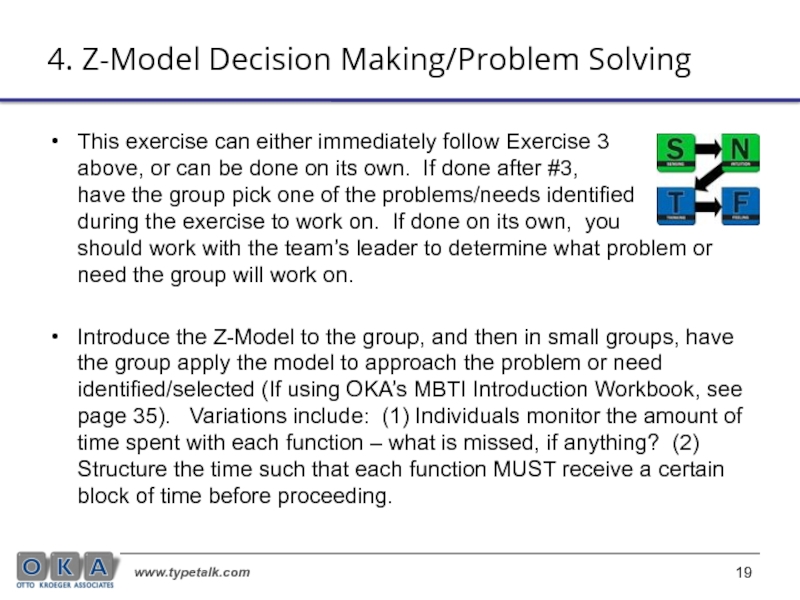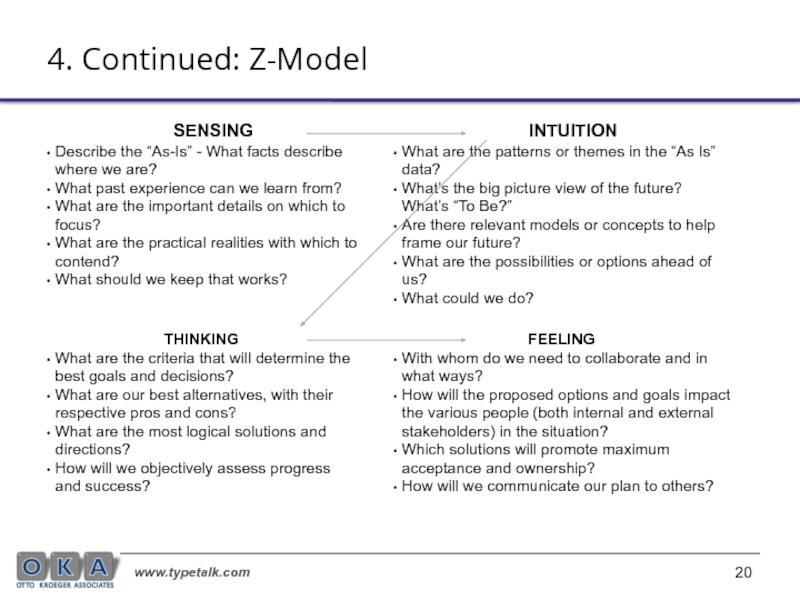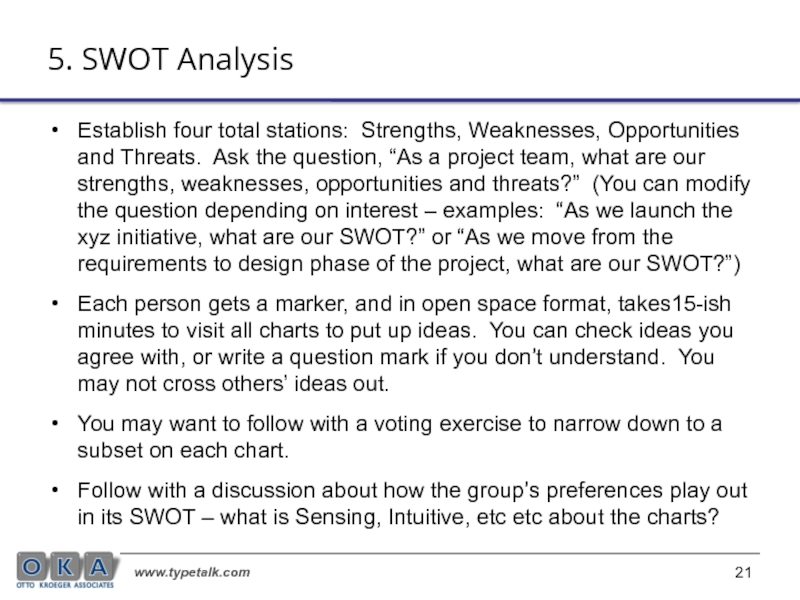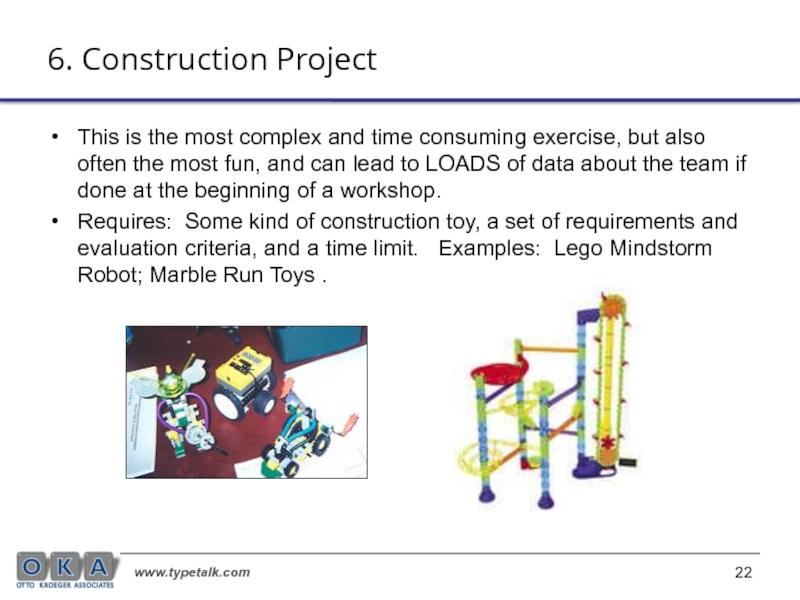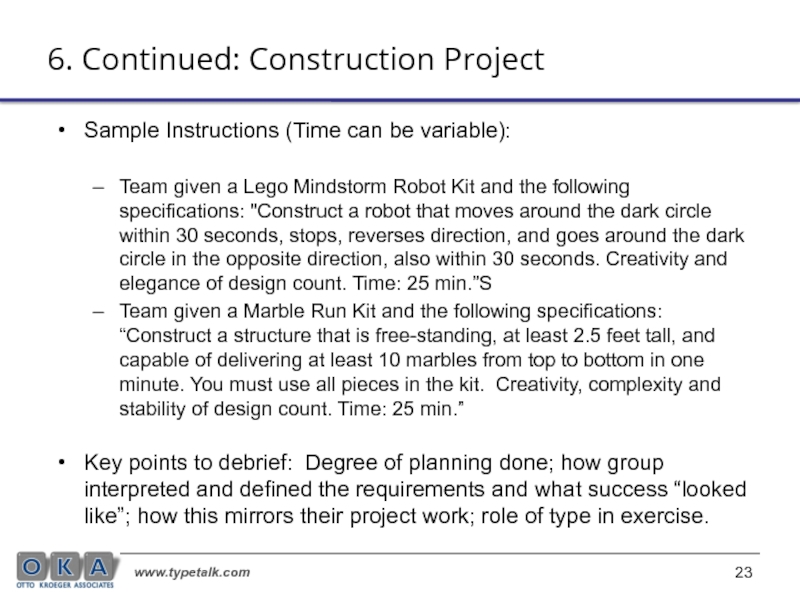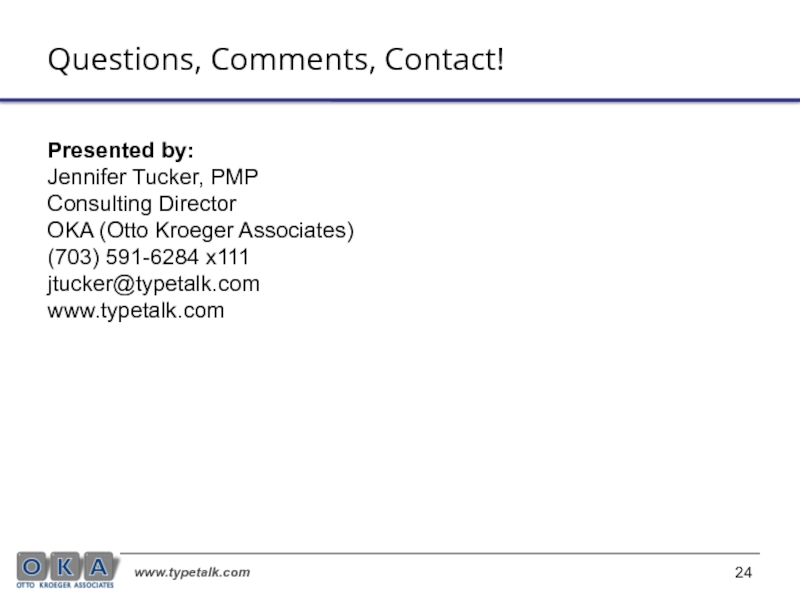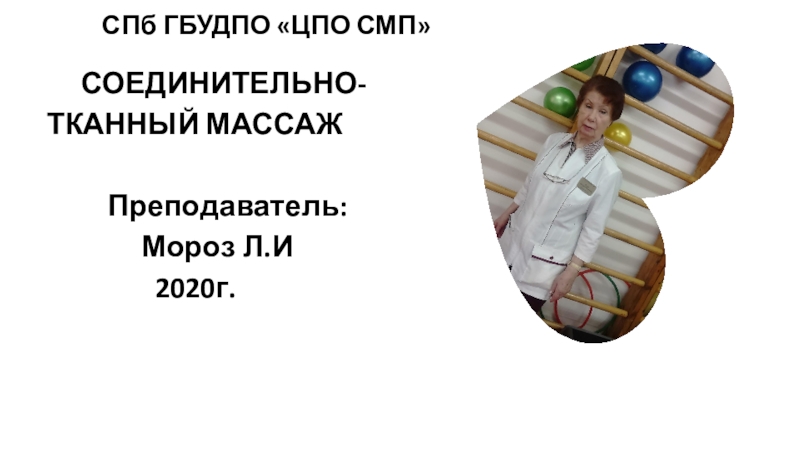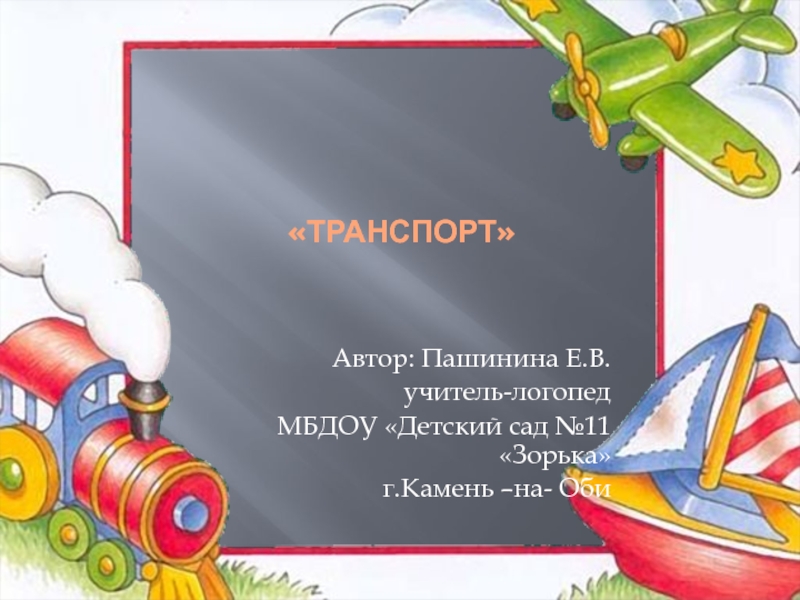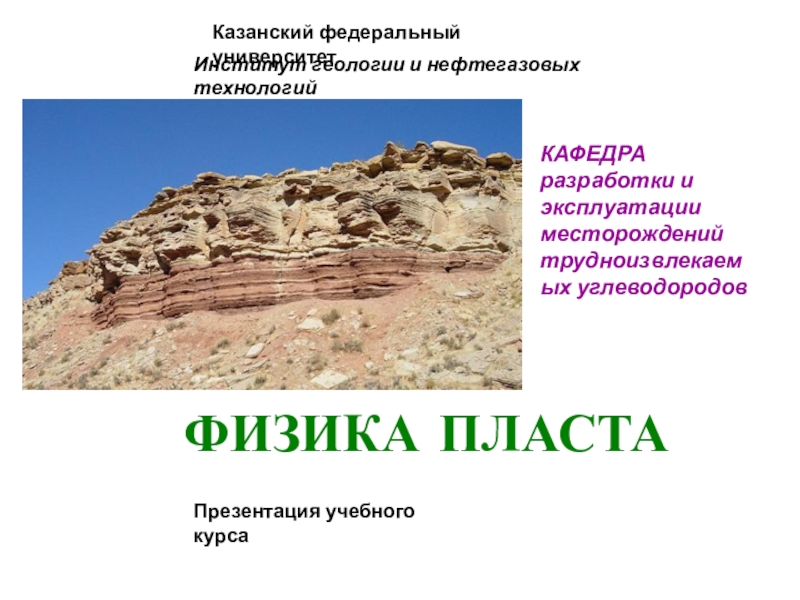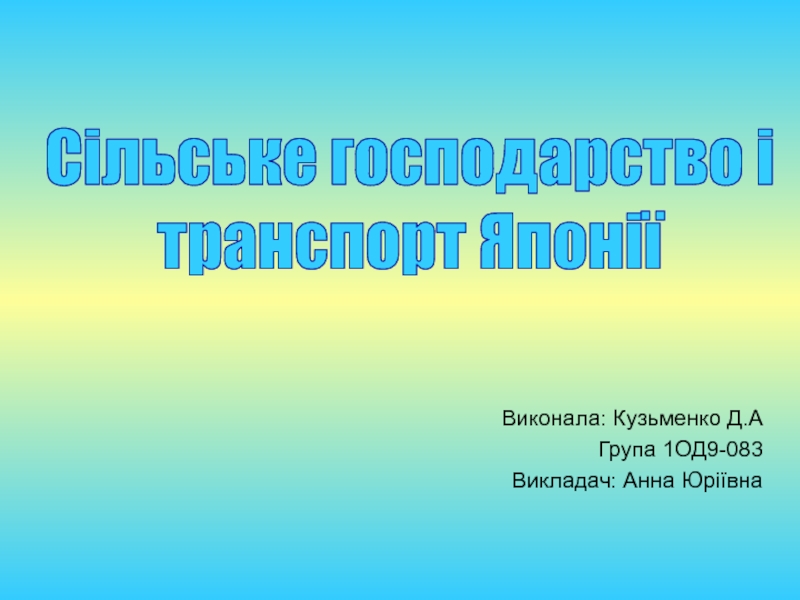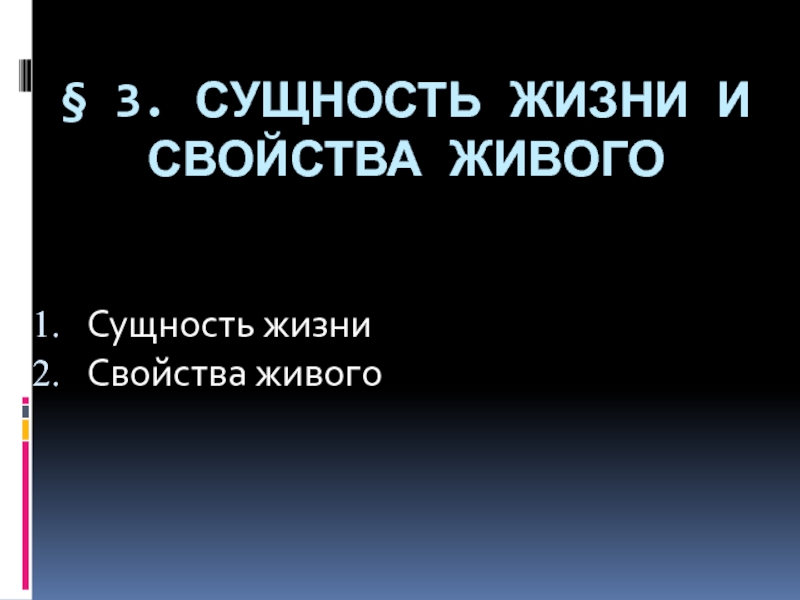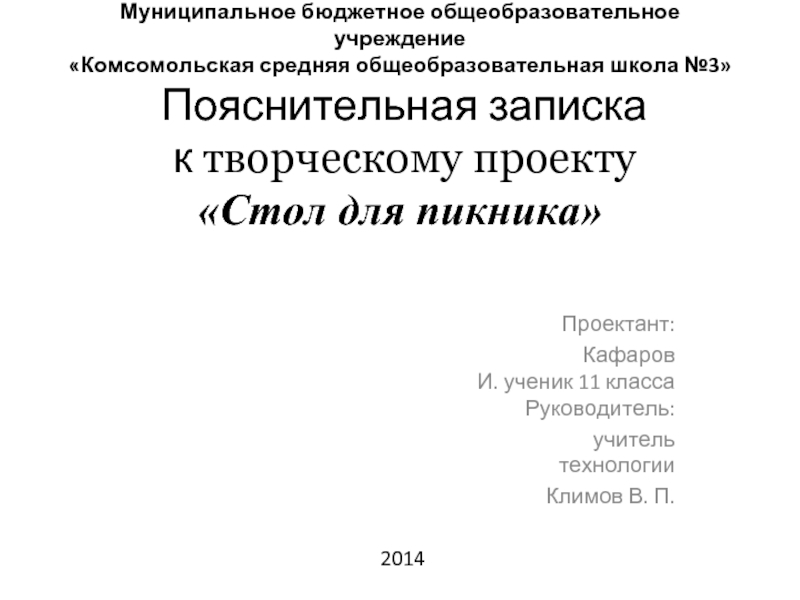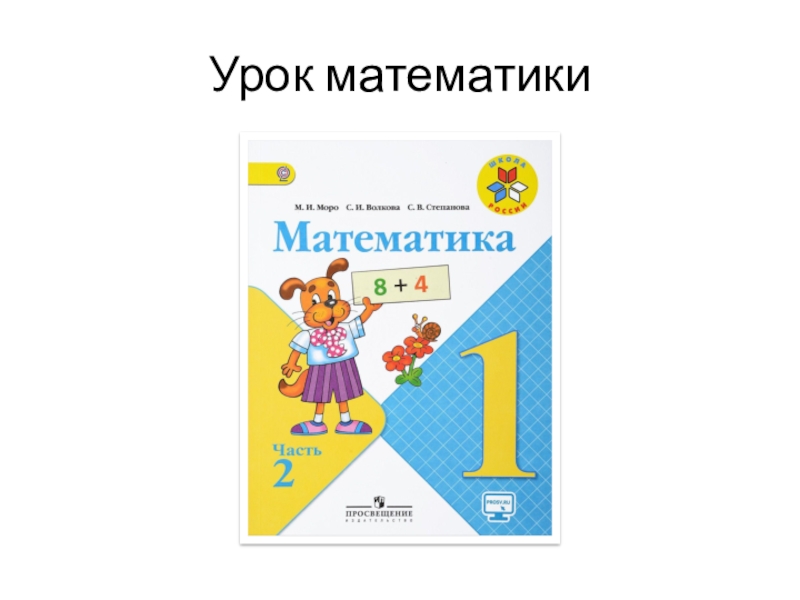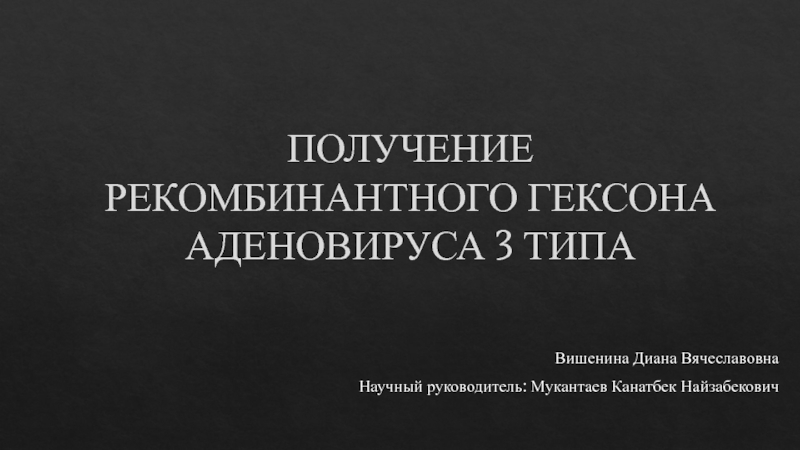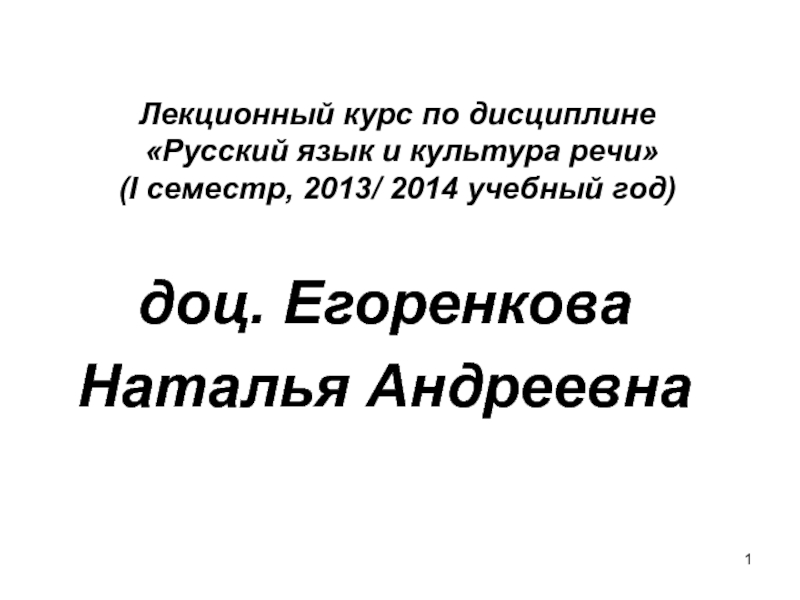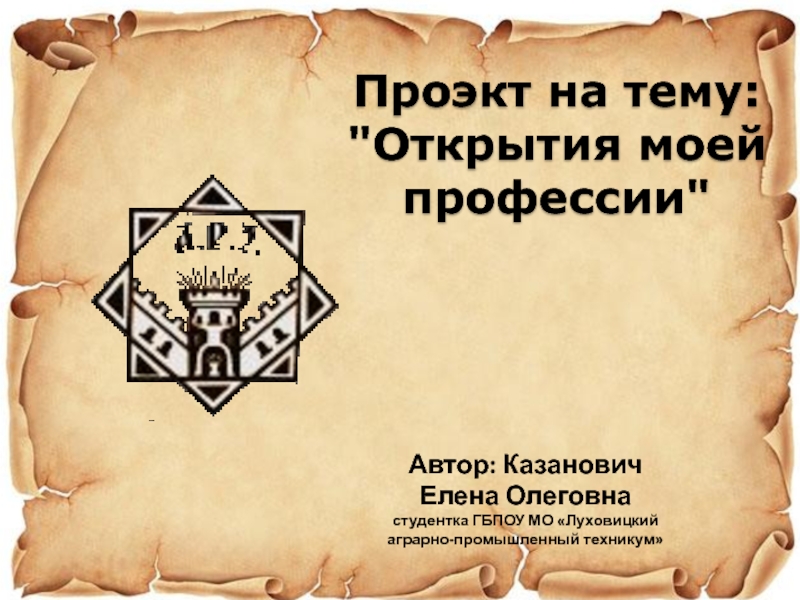Разделы презентаций
- Разное
- Английский язык
- Астрономия
- Алгебра
- Биология
- География
- Геометрия
- Детские презентации
- Информатика
- История
- Литература
- Математика
- Медицина
- Менеджмент
- Музыка
- МХК
- Немецкий язык
- ОБЖ
- Обществознание
- Окружающий мир
- Педагогика
- Русский язык
- Технология
- Физика
- Философия
- Химия
- Шаблоны, картинки для презентаций
- Экология
- Экономика
- Юриспруденция
Type & Project Management: Putting Type on the Critical Path
Содержание
- 1. Type & Project Management: Putting Type on the Critical Path
- 2. AgendaIntroduce key elements of the project life
- 3. Project Management TalkThe Project Management Body of
- 4. Project Management ActivitiesNeeds StatementInitiationProject CharterScope
- 5. What Makes Projects Succeed? User Involvement –
- 6. And Why Do They Fail? Inability to
- 7. Learning Quickly About A Project
- 8. Bringing in Psychological TypeJust as there are
- 9. Bringing in Psychological Type
- 10. Extraversion and Introversion on Projects
- 11. Sensing and Intuition on Projects
- 12. Thinking and Feeling on Projects
- 13. Judging and Perceiving on Projects
- 14. Getting Things Back on Track: One Conversation
- 15. Exercises “Project in Progress” Ranking ExerciseCase Study
- 16. 1. “Project in Progress” - Ranking ExerciseRank
- 17. 2. Case Study ExerciseEstablish eight total stations
- 18. 3. Function Pair or Temperament Exercise Split
- 19. 4. Z-Model Decision Making/Problem Solving This exercise
- 20. 4. Continued: Z-Model
- 21. 5. SWOT AnalysisEstablish four total stations: Strengths,
- 22. 6. Construction Project This is the most
- 23. 6. Continued: Construction Project Sample Instructions (Time
- 24. Questions, Comments, Contact! Presented by:Jennifer Tucker, PMP Consulting Director OKA (Otto Kroeger Associates)(703) 591-6284 x111jtucker@typetalk.comwww.typetalk.com
- 25. Скачать презентанцию
Слайды и текст этой презентации
Слайд 1Type & Project Management:
Putting Type on the Critical Path
Presented by:
Jennifer
Tucker, PMP
Consulting Director
OKA (Otto Kroeger Associates)
Слайд 2Agenda
Introduce key elements of the project life cycle – and
the language that drives project managers and their teams.
Explore
how type can be seen across projects of all sizes and kinds, and used as a diagnostic tool.
Discuss and share type-related training designs that type professionals can use with project teams.
Слайд 3Project Management Talk
The Project Management Body of Knowledge (PMBOK) describes
a project as:
A project is a temporary endeavor, undertaken
to create a unique product or service. This means that every project has a definite beginning and a definite end. A project team – as a team – seldom outlives the project. Once the project is complete, they are disbanded, and members move on to other projects and other teams.
Projects are first and foremost outcome driven – it is the ultimate product or service, assessed against performance measures, which determines project success.
Слайд 4Project Management Activities
Needs
Statement
Initiation
Project
Charter
Scope
Definition
Outcome
Measures
Work
Breakdown
Structure
Schedule
Planning
Milestones
Cost
Estimates
Resource
Needs
Communication
(Internal/External)
Organization
&
Integration
Quality
Risk
Execution, Monitoring & Control
Project
Management
Plan
Deliverables &
Performance
Measures
Human Resources
(People)
Contracts/
Procurement
Schedule/Cost
Management
Resources
Closing
Project
ReviewFinal
Products
Close-out
Activities
Knowledge
Library
Слайд 5What Makes Projects Succeed?
User Involvement – 19
Executive Management Support
– 16
Clear Statement of Requirements – 15
Proper Planning – 11
Realistic
Expectations – 10Smaller Project Milestones – 9
Competent Staff – 8
Ownership – 6
Clear Vision & Objectives – 3
Hard-Working, Focused Staff - 3
Source: Standish Group – “Unfinished Voyages - A Follow-Up to The CHAOS Report” (http://www.standishgroup.com/sample_research/unfinished_voyages_1.php)
Слайд 6And Why Do They Fail?
Inability to succinctly communicate overarching
goals
Poor client management and communication skills
Failure to manage scope creep
Failure
to differentiate between customer groupsTeam ramp-up time complicates early activities
Lack of team and meeting management skills
Over-emphasis on risk management – dampening creativity
Project team burn-out; no “buffer” time for crises
Failure to maintain upper management support
Слайд 8Bringing in Psychological Type
Just as there are individual types and
team types, there are project types – project characteristics that
align with the eight preferences.Examples – Projects are often:
Externally Facing OR Internally Focused
Fact Driven OR Possibilities Driven
Product Focused OR User Focused
Ruled by Milestone OR Reactive to Change
Reference: Tucker, J (2008) Introduction to Type and Project Management. CPP, Inc.
Слайд 14Getting Things Back on Track:
One Conversation at a Time
Communication
and Information Flow
Alignment of Authority, Accountability and Responsibility
Structural and Role
ClarityBalancing Process and Product
Balancing Procedural Clarity with Flexibility and Trust
Effective Conversations and Giving Frequent Feedback
Слайд 15Exercises
“Project in Progress” Ranking Exercise
Case Study Exercise
Function
Pair or Temperament Exercise
Z-Model Decision Making/Problem Solving
SWOT Analysis
Construction Project Each of the following slides proposes exercises for exploring type and project management. The slide presents the exercise set-up – the trainer or facilitator’s debrief depends on the content generated. The primary goal is to reveal insights that lead to concrete action plans that the team can carry forward after the workshop.
Слайд 161. “Project in Progress” - Ranking Exercise
Rank the following project
management activities in order of importance:
A - Conducting regular
project reviews and “lessons learned” meetings B - Assessing progress of activities against work breakdown structure and adjusting as needed.
C - Monitoring and updating risks, and implementing risk mitigation plans as needed.
D - Meet with project sponsor and external stakeholders to report on progress and solicit feedback
E - Conduct one-on-one meetings with key project members to give feedback.
F – Respond in real time to emerging project crises or emerging needs/requirements.
G – Review financial status (including staffing levels and budget) of project spending against plan
H – Conduct formal reviews of work deliverables and products and introduce corrective measures
I – Conduct team meetings to share updates and do cross-project problem solving.
J - Revisit Project Charter and Needs Assessment to identify current activities that are out of scope
Source: Tucker, J (2008) Introduction to Type and Project Management. CPP, Inc. - PAGE 11
Слайд 172. Case Study Exercise
Establish eight total stations around the room
– four have the preference pairs (E/I, S/N, T/F, J/P);
and four have case studies (select mini-case studies from “Introduction from Type and PM”).Instructions for Preference Charts: For each preference, give: (1) Examples of what it “looks like” on a project where preference is deployed well. (2) Example of what it “looks like” on a project where a preference is either over-used or under-used (too much, not enough)
Instructions for Case Studies: Write concrete actions or approaches you would take to address the challenges in each case study.
Visit as many or as few charts as you want.
Слайд 183. Function Pair or Temperament Exercise
Split groups into either
function pairs (NT, NF, ST, SF) or temperament groups (NF,
NT, SJ, SP) depending on group distribution and workshop design.Question (2 parts): (1) Identify the one problem or need that your group thinks is the most important for this project to fix or address. Present to the group in the form of a problem or need statement. (2) What initial approach or options would you propose to begin to address this?
Each group debriefs to full group.
Слайд 194. Z-Model Decision Making/Problem Solving
This exercise can either immediately
follow Exercise 3 above, or can be done on its
own. If done after #3, have the group pick one of the problems/needs identified during the exercise to work on. If done on its own, you should work with the team’s leader to determine what problem or need the group will work on.Introduce the Z-Model to the group, and then in small groups, have the group apply the model to approach the problem or need identified/selected (If using OKA’s MBTI Introduction Workbook, see page 35). Variations include: (1) Individuals monitor the amount of time spent with each function – what is missed, if anything? (2) Structure the time such that each function MUST receive a certain block of time before proceeding.
Слайд 215. SWOT Analysis
Establish four total stations: Strengths, Weaknesses, Opportunities and
Threats. Ask the question, “As a project team, what are
our strengths, weaknesses, opportunities and threats?” (You can modify the question depending on interest – examples: “As we launch the xyz initiative, what are our SWOT?” or “As we move from the requirements to design phase of the project, what are our SWOT?”)Each person gets a marker, and in open space format, takes15-ish minutes to visit all charts to put up ideas. You can check ideas you agree with, or write a question mark if you don’t understand. You may not cross others’ ideas out.
You may want to follow with a voting exercise to narrow down to a subset on each chart.
Follow with a discussion about how the group’s preferences play out in its SWOT – what is Sensing, Intuitive, etc etc about the charts?
Слайд 226. Construction Project
This is the most complex and time
consuming exercise, but also often the most fun, and can
lead to LOADS of data about the team if done at the beginning of a workshop.Requires: Some kind of construction toy, a set of requirements and evaluation criteria, and a time limit. Examples: Lego Mindstorm Robot; Marble Run Toys .
Слайд 236. Continued: Construction Project
Sample Instructions (Time can be variable):
Team given a Lego Mindstorm Robot Kit and the following
specifications: "Construct a robot that moves around the dark circle within 30 seconds, stops, reverses direction, and goes around the dark circle in the opposite direction, also within 30 seconds. Creativity and elegance of design count. Time: 25 min.”STeam given a Marble Run Kit and the following specifications: “Construct a structure that is free-standing, at least 2.5 feet tall, and capable of delivering at least 10 marbles from top to bottom in one minute. You must use all pieces in the kit. Creativity, complexity and stability of design count. Time: 25 min.”
Key points to debrief: Degree of planning done; how group interpreted and defined the requirements and what success “looked like”; how this mirrors their project work; role of type in exercise.
